Morgan Sjogren and Michael Versteeg explore whether staking a mining claim in former Bears Ears monument land could be an unusual public lands preservation tactic.
“Keep digging!”
I’m slinging an ice axe like a backhoe into the muddy road on Deer Flat, a stretch formerly within the boundaries of Bears Ears National Monument. My partner, Michael Versteeg, spurs me onward as he too uses his ice axe in an attempt to dig out the front tire of our van, buried up to the wheelbase in the hellacious clay that keeps most everyone off this high-elevation mesa during winter. We are completely stuck and it’s obvious no one has driven down any of these San Juan County roads in weeks.
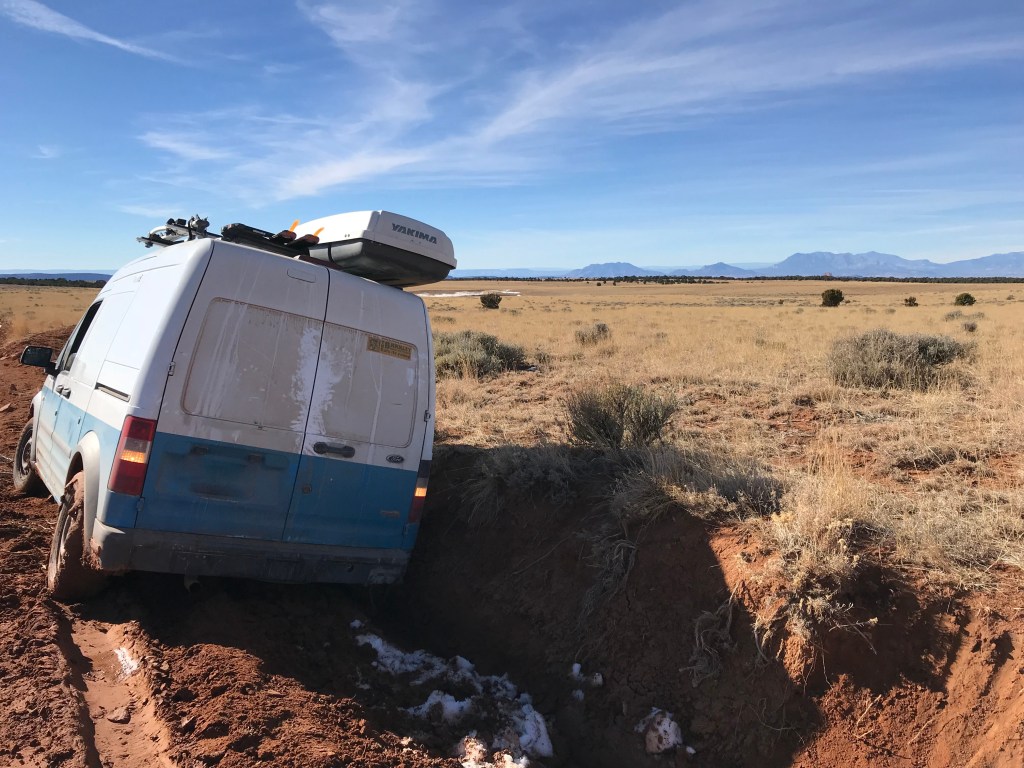
“The only actual mining we did: digging out the van from slick mud atop Deer Flat,” Morgan says. (Photo Credit: Morgan Sjogren)
It’s hard not to laugh amid our deep frustration and the sweat on our brows, but we press on. We came here to investigate. We’re outdoor athletes staking a mining claim, with no intention of mining.
On Feb. 2, this swath of Utah land*, overseen by the Bureau of Land Management (BLM), was reopened to mining claims. Places like Deer Flat are no longer protected within Bears Ears, along with critical areas that used to be part of Grand Staircase–Escalante National Monument. The loss of protection is a result of President Trump’s December announcement allowing public land boundaries to be reduced. Now, more than 1 million acres are potentially open to “mining, drilling and other industrial activity,” according to The New York Times.
In preceding weeks, news media explored whether there might be an 1870s-style land rush on the now-unprotected land. Headlines read: “A Modern Land Run? Trump move opens Utah to mining claims under 1872 law” (Reuters) and “Uranium Miners Pushed Hard for a Comeback. They Got Their Wish.” (The New York Times). So far we haven’t seen any miners. We haven’t seen anyone. Just Michael Versteeg—writer, climber and Arizona Trail FKT holder—and me, covered in mud, toiling with our “mining tools” to unearth the van, which appears to be perilously close to making Deer Flat its new winter homestead.
The archaic mining laws governing this process were written nearly 150 years ago, raising important questions of efficacy and relevance in 21st century land management: How simple is it to stake a mining claim? How does this process work? Would it be possible for us to go and stake a mining claim, and if so, could it be used as a land preservation tool?
Just a week before the administration’s decision to resize Bears Ears and Grand Staircase took effect, we dreamed up the scenario of effectively “racing” miners in order to “block” them. If successful, perhaps larger conservation groups and corporations could follow suit and we could collectively protect these sensitive areas that are susceptible to future mining.
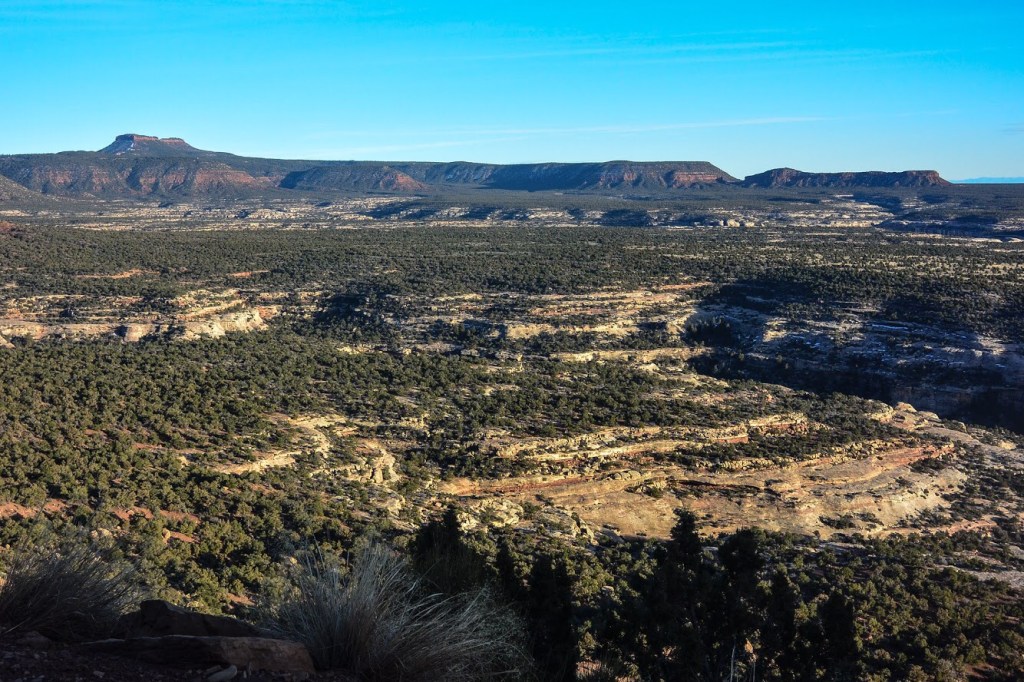
Photo Credit: Morgan Sjogren
We derived the concept of using a mining claim as a potential preservation tool from Michael’s research for an essay he penned about cattle ranching on public lands. He learned about an interesting “fight fire with fire” tactic attempted by the Grand Canyon Trust in Grand Staircase–Escalante National Monument in the ‘90s. Michael explains, “The nonprofit purchased some cattle grazing leases to attempt to preserve sensitive areas but that also required leaseholders to actually graze. And just like that, the Grand Canyon Trust entered the cattle business.”
At best, we could use this tactic by staking a mining claim to potentially protect 20 acres of land from mining, while also learning a great deal about the multi-use of our public lands system. In our quest, we quickly discovered the process of staking a claim is not nearly as simple as it sounded.
And if we staked a claim, would we have to actually mine? After all, this would directly counter our original objective (to preserve and protect a swath of land from new mining) and it isn’t really a career path either of us are considering. According to the General Mining Law of 1872, striking a claim requires the following:
- Erecting corner posts or monuments
- Placing a monument in a conspicuous place (This can be a three-foot-high stone mound, wooden post or metal post.)
- Posting a location notice on the monument that must include: the date and location on the ground, the names and addresses of the locators, the name of the claim or site, the acreage claimed and a description of the parcel on the ground (This does not qualify as an official “discovery” of a valuable mineral but simply a claim.)
- Complying with the requirements of 43 CFR Part 3830, 3832 and 3833 (which implies figuring out what the heck 43 CFR Part 3830, 3832 and 3833 means)
As we read through the mining resources available on the BLM’s website, it appeared to us that striking a claim only required that we:
- Not put down stakes on prohibited land (like a national monument, which inhibits new claims but not pre-existing claims) or on someone else’s claim
- Follow the exact parameters/instructions for the type of claim (lode or placer—ours would be a lode)
- Record the site with the county clerk (which costs $12)
- Send the recorded documents to state BLM headquarters and pay your fees ($212)
Should your mining claim be approved by the BLM headquarters via this process, you are only required to complete the annual maintenance and assessment work (valued at $100 in improvements to your claim) or file for a waiver (this is the 43 CFR Part 3830, 3832 and 3833 stuff).
In fact, if you do wish to actually mine, staking a claim does not give you the right to actually do so. According to the BLM brochure for mining claims on federal lands, there must be a proven discovery of a valuable hard mineral (another process altogether). If you stake a claim but make no discovery, it is even possible for someone else to come and discover something before you do and take over your claim via a court dispute. Another key piece of information: If you actually make it past these stages, having a claim does not mean you own the land; it merely gives you permission to extract surface minerals. Following the multi-use ethos of the BLM, it is perfectly legal for gas and oil leases, cattle grazing, recreation and any other permissible use to co-exist within the plot of land where you are mining. So, even if we were successful in staking a claim and making a valuable mineral discovery, we would only potentially be protecting 20 acres from other mining activities and not other uses.
To ensure we had all of the correct information and to procure the proper forms, we headed straight for the Monticello, Utah, BLM office on Jan. 31. Dressed in our working pants, brimmed hats and boots, and plenty dirty after living on the road for several weeks (skiing, ice climbing and exploring hot springs all over the West), we certainly felt we looked the part. Here, most of our remaining questions were answered and we were able to get hard copies of the information available online.
Back in the van, I time traveled deep into 147-year-old mining laws and history, while Michael had a modern breakthrough—LR2000. This is the software program the BLM uses to record all active, pending and closed mines, and therefore, our key to discover where mines have been claimed in our areas of interest and what 20-acre plots were still available. Upon entering the world of LR2000, he was treated to a complicated system, difficult even for a man who used bioinformatics (aka complicated computer codes) to study anthrax in a Northern Arizona University lab in his past life. Michael furiously scribbled down numbers and drew lines across our Cedar Mesa/Grand Gulch topo maps and, before the lunch hour was up, had uncovered the information needed to locate mines or free spaces to claim.
We hit the road with stakes in the trunk and dreams of protecting 20 acres of land. Our first stop was the former eastern boundaries of Bears Ears (about two hours outside the town of Blanding) to locate what other claims look like for inspiration and instruction. The area is dotted with active and inactive claims staked next to one another for miles, and all are as simplistic as the 1872 law explicates—four metal stakes in the ground and a monument post in the center. Some mines did have piles of tailings and remnants of old mining activity, like rusted tools and tin cans.
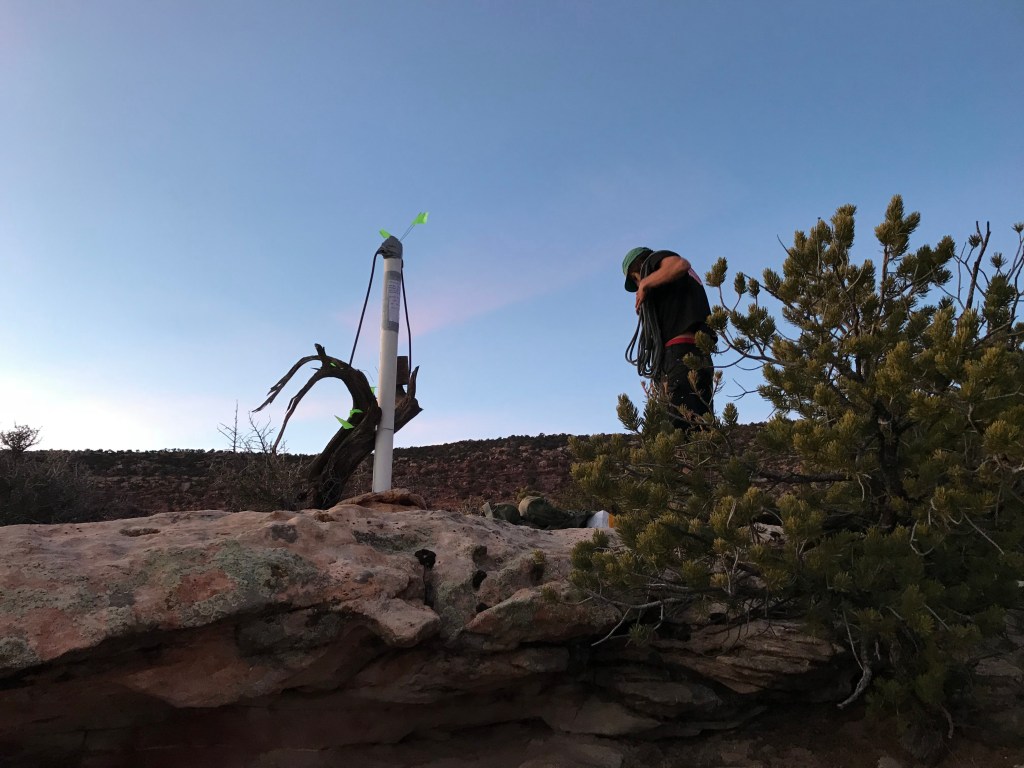
Michael Versteeg prepares to place stakes 660 feet from their monument, per the requirements of a lode mining claim. (Photo Credit: Morgan Sjogren)
Ready to stake our claim, we made our way up Deer Flat, a plateau on the southwest edge of Elk Ridge, an area rumored to hold the next boom of mining activity in the area, and according to LR2000, also heavily staked out (likely pre-existing claims). As we drove up the winding dirt road, I took in the beautiful views of White Canyon dropping sharply next to us, and the actual “bears ears,” two distinctly shaped, high-elevation Wingate sandstone mesas, in the distance—reminders of the true reason we are here.
High on Deer Flat, conditions changed rapidly. A thin and melting layer of old snow sat atop a perilously thick and slick layer of muddy clay. Our van skidded into a thigh-high dirt embankment, delaying us four hours.
It was 4pm on Friday and we had nothing to show for our work except a damn near empty gas tank and everything we needed to stake a claim. After freeing our van, Michael and I looked at each other—why not keep going? Windows down, I hung my head out scouting locations as my tumbleweed of blonde hair whipped around in the wind. We settled on a spot just below the road that jutted out across the rim of Deer Canyon. We pulled over and loaded up our packs with four metal stakes, materials for our monument and location notice sign, a climbing rope (to measure the dimensions of our lode claim), an ice axe and a few beers. We jumped down the sandy roadside, hopped over the boulders and tiptoed around cacti.
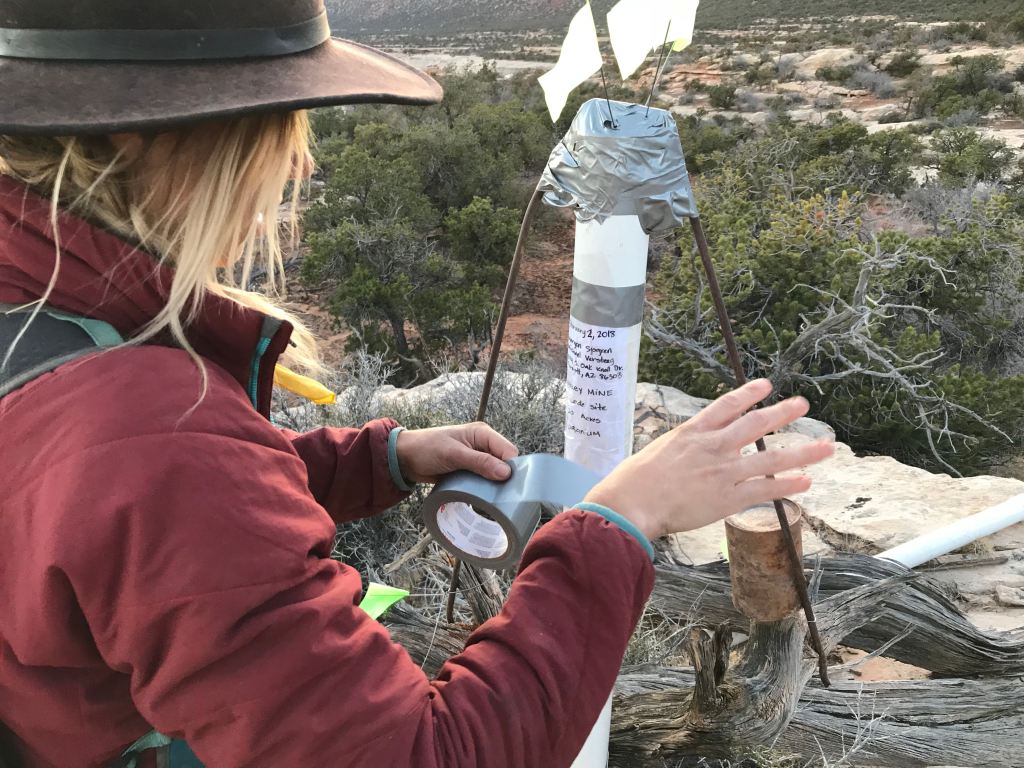
Morgan Sjogren tapes the notice of location to the monument at the center of their mining claim. (Photo Credit: Morgan Sjogren)
“This is it!” Michael stood on top of a rocky outcropping, declaring the place for our monument. He hammered metal stakes into the ground with an ice axe and inserted a 4-foot length of plastic tubing and built a rock pile to support the base. I taped our location notice across the finished design officiating our claim. The moment stung with irony—how much time, work and money we put in this week for an unknown, if not outright frivolous outcome. The only claim we were staking was our love for the land.
As the sun set, Michael and I came to terms with the fact that we would not be able to finish staking our claim before dark. We set up camp alongside our mine and devoured beans and tin cups of whiskey as the stars appeared overhead. I lay wide-awake all night wondering about the uncertain future of this incredible place.
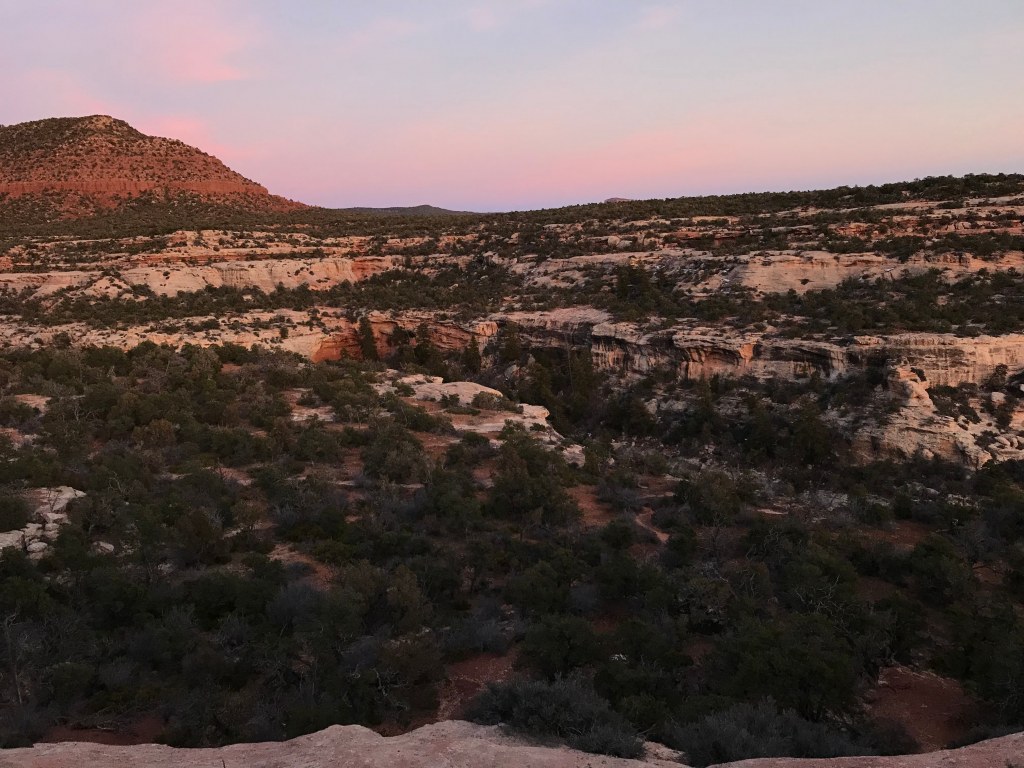
The sun sets over areas formerly within the boundaries of Bears Ears National Monument. (Photo Credit: Morgan Sjogren)
Saturday was another working day as we hauled our packs back to our mine monument first thing in the morning. Using our 70-meter climbing rope, we measured and selected the locations for our four stakes. We scrambled over slick rock, held the rope across wide ledges and crawled through dense juniper trees. At each stake, we stopped to take in the views that ranged from dripping springs to sandstone towers, and then moved on to our next marker.
We staked the claim in less than half a day, making this surprisingly the quickest part of the entire process. But since it was a Saturday, we had to wait around until Monday to record the claim with the county clerk and mail the finished documents along with a check to the BLM headquarters in Salt Lake City.
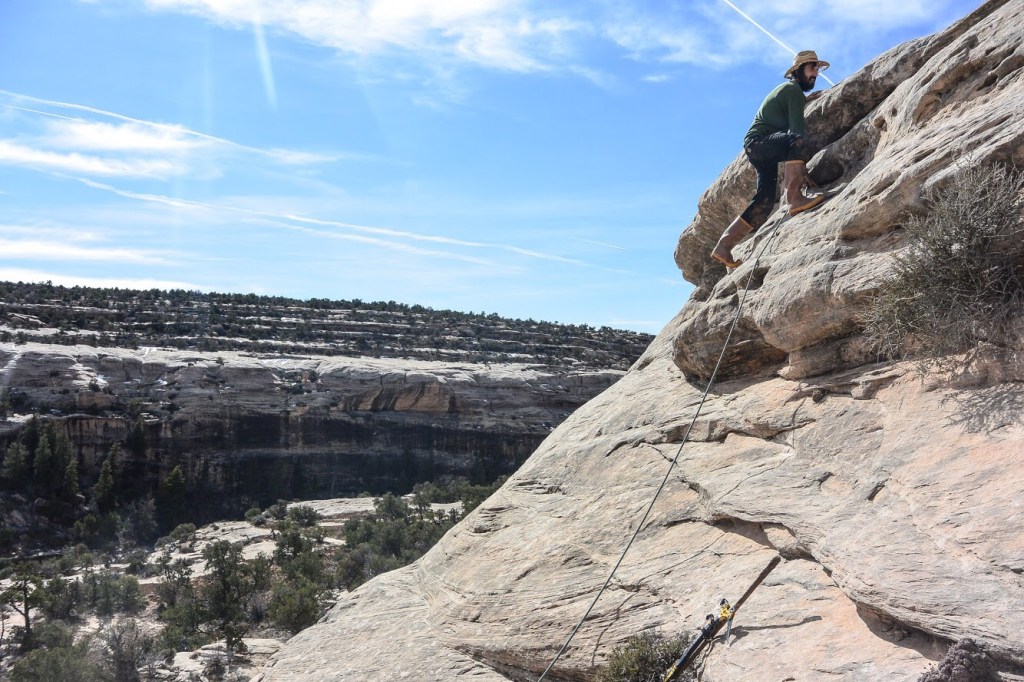
Their claim sits on the edge of a canyon, which made staking it another adventure all its own. (Photo Credit: Morgan Sjogren)
In total it took us six days to research, stake and file for a mining claim. We asked the clerk’s office staff whether they saw a bump in claims since Feb. 2 and they gave no indication there was any activity beyond normal. The LR2000 software can take weeks to update, in addition to the 30 days notice allowed between the date of staking and filing a claim. Therefore, it is yet to be seen whether there was any increase in recent mining claim activities. We did, however, connect with an NBC Left Field reporter, Ali Withers, who came to the area to test the same concept. She completed the process and her approval is still pending. The Salt Lake City BLM office did send us the stamped paperwork for our officially accepted claim dated Feb. 7, along with 36 pages of reference materials—an A+ in the lengthy test of successfully staking a mining claim.
So what was the point?
This is a question Michael and I wrestled with throughout the experience and still do to this day. Our research early on quickly made us aware of just how insignificant our actions would likely be in terms of preserving land. At best, if we executed all procedures to a T (check), paid our fees (check), made a valid and successful discovery of a valuable hard mineral, and maintained and improved our 20 acres, we could potentially prevent someone else from actually mining directly within our plot. Is this a valid way to protect critical areas left out of the new Bears Ears and Grand Staircase–Escalante National Monuments from mining? It certainly is not a very efficient nor an affordable one. Although we plan to maintain and improve the plot at least for the year we are contracted to do so for our claim, it remains to be seen how challenging it will be to hold on to it for that length of time. After all, someone could make a discovery of a valuable mineral and “claim jump” us.
Ultimately, I found that staking your claim isn’t about hammering posts into the ground. It’s about exploring our public lands, learning as much as you can about them and why they need to be protected.
*Author’s note: Although the specific statements about our experience in Bears Ears cannot be directly applied to land no longer protected within Grand Staircase–Escalante National Monument—which for instance is being scouted for coal mining versus uranium—we learned that the processes of staking a claim and outcomes as a preservation tactic are very much the same.


